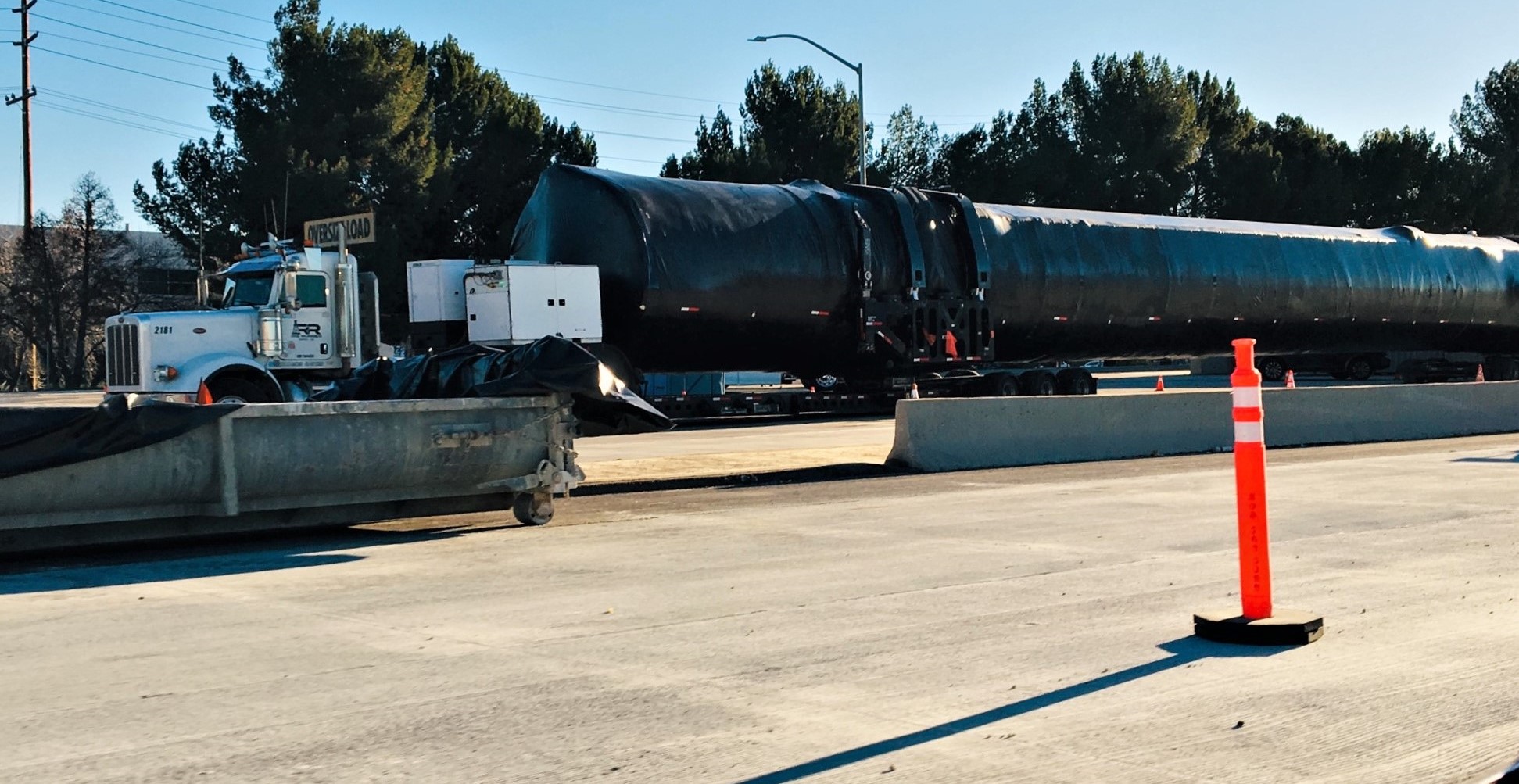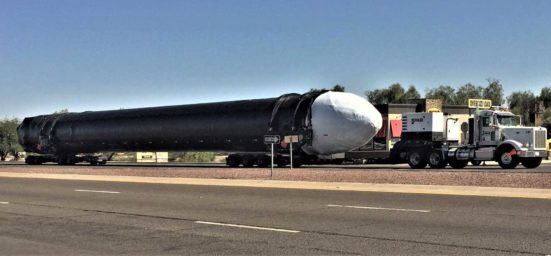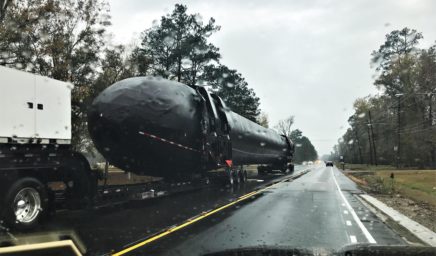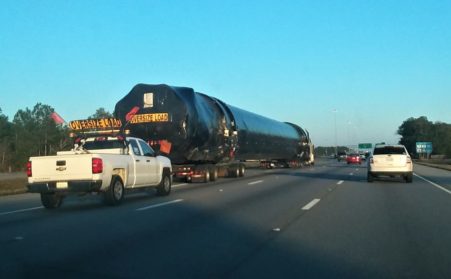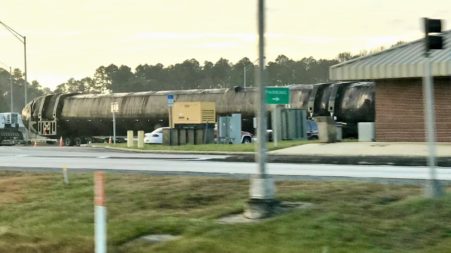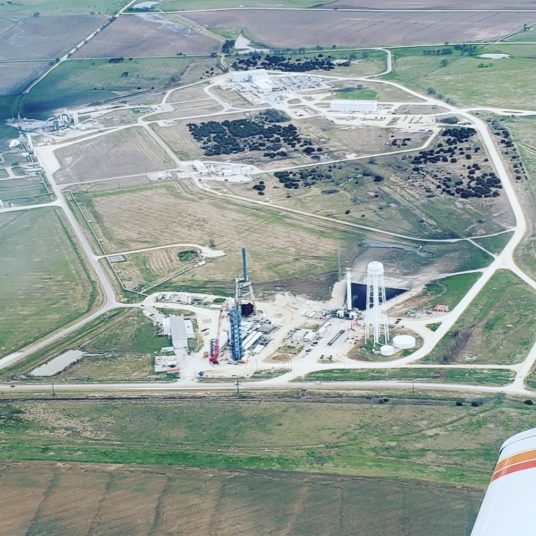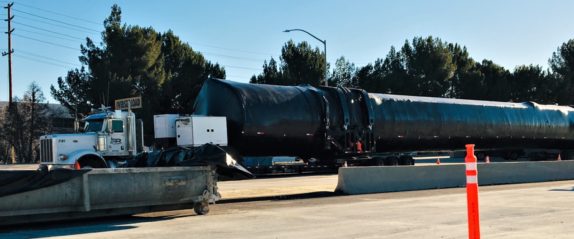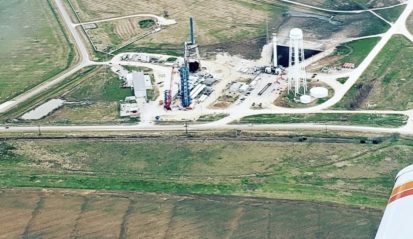A SpaceX Falcon 9 booster was spotted heading north from the company’s Hawthorne, California factory on January 22nd, signifying a likely shipment of the flight-proven rocket that will help launch Canada’s trio of Radarsat Constellation Mission satellites.
Delayed from mid-February to early March 2019 after an unplanned landing anomaly damaged the Falcon 9 originally assigned to the mission, the shipment of a different booster to Vandenberg Air Force Base (VAFB) helps to narrow down the rocket now likeliest to launch the Canadian Space Agency’s (CSA) radar satellite constellation.
It appears a first stage is headed north to Vandenberg AFB, possibly for the RadarSat launch scheduled for next month https://t.co/fTSEJLsb1p // cc: @13ericralph31
— You Are Go For Staging (@GoForStaging) January 23, 2019
Do the Booster Shuffle!
Thanks to a hydraulic pump failure that led Falcon 9 B1050 to land (albeit softly and in one piece) in the Atlantic Ocean last December, the imminent launch of two booster-dense Falcon Heavy missions, and the thus far schedule-shy orbital launch debut of Crew Dragon, SpaceX’s fleet of available boosters – all flight-proven – can be succinctly summarized as “B1046 thru B1049”.
B1050’s future is uncertain after suffering a smashed interstage and soaking in salt water for several days, while B1051 is definitively assigned to Crew Dragon’s orbital launch debut, known as Demo-1 (DM-1). Falcon 9 B1052 and B1053 are unknown quantities and B1054 was expended after a high-value US Air Force launch, also SpaceX’s final mission of 2018. It’s probably safe to bet that B1052, B1053, and B1055 will be the next three boosters to support a Falcon Heavy launch (or two), currently NET March and April 2019. All three of those Falcon Heavy (FH) boosters have completed static fire tests in Texas and both side boosters arrived at SpaceX’s Florida facilities within the last ~6 weeks.
Assuming that Falcon Heavy Flight 2 and 3 use the same exact boosters, SpaceX production technicians and engineers may already be nearing the completion of another Falcon 9 booster (B1056, presumably) at the Hawthorne factory, although they are likely 1-2 weeks away from that milestone. If, Falcon Heavy Flight 3 (presumed to be the USAF’s STP-2 mission) does not reuse all three first stage boosters from Flight 2 (commercial payload Arabsat 6A), then Hawthorne will have to build, ship, and test anywhere from 1-3 additional boosters between now and April 2019. In the latter scenario, all unflown – mid-build or completed – Falcon boosters would be ‘claimed’ between now and March or April.
Put in another way, short of opting for a delay that could stretch 1-4 months or longer, the Canadian Space Agency (CSA) and Radarsat prime contractor MDA will have to accept one of SpaceX’s flight-proven Falcon 9s.
Falcons on wheels
Thanks to SpaceX’s trusty and well-worn method of using good old trucks and roads to transport Falcon 9 and Heavy boosters, upper stages, fairings, landing legs, and much more cross-country, spaceflight fans have long taken advantage of opportunities – rare and fleeting as they might be – to spot and track SpaceX hardware on public roads. Put simply, a lot of people are excited about SpaceX or are at least familiar and curious enough to know someone to share a photo or observation with. As a result, the community averages dozens of ‘core spottings’ per year. With a little intuition, the process of elimination, a few sources, and some wild guesses, this allows unofficial fans to (very roughly) paint a picture of SpaceX’s fleet of rockets.
For example, the Falcon 9 spotted in Valencia, CA on January 22nd by Reddit user intamin1 could theoretically be any SpaceX booster currently in existence. By knowing the rough state of SpaceX’s fleet (as described above) and observing that the booster was northbound between Hawthorne, CA (the factory) and Vandenberg Air Force Base (VAFB) on Jan 22, a great deal can be intuited. Bound for SpaceX’s West Coast launch complex (SLC-4), it ought to be flightworthy. Knowing that a Falcon Heavy center booster was on SpaceX’s McGregor, Texas static fire stand on January 10th means that the spotted booster can’t (or at least shouldn’t) be coming from Texas, as Falcon Heavy has no known launches planned from VAFB. The process of testing, inspecting, and preparing Falcon boosters for cross-country shipment is also not easily rushed.
On the East Coast, SpaceX needs to launch communications satellite PSN-6 and Spaceflight rideshare GTO-1 in mid to late February. With no new boosters expected to be easily available for months and PSN-6/GTO-1 already entering into the phases of payload fueling, integration, and fairing encapsulation, it can be all but guaranteed that a flight-proven booster was assigned to the mission months ago and is now nearly ready for its third flight somewhere in Cape Canaveral, FL.

Given that B1046 and B1049 are on the West Coast after conducting launches from VAFB and that B1050 is out of circulation for the time being, only B1047 and B1048 remain (in theory) on the East Coast, both having flown two missions. B1048 was recently spotted and confirmed in photos of SpaceX’s Pad 39A integration hangar, although Falcon 9 B1051 and the first orbit-ready Crew Dragon were the center of attention.
B1047 completed its second launch in mid-November 2018 and returned to one of SpaceX’s Florida hangars for refurbishment around Nov 21. Unless any number of locals and bystanders somehow missed it, neither booster has left the Cape since arriving. Meanwhile, B1048 is currently the best-known candidate at hand for SpaceX’s Crew Dragon In-Flight Abort (IFA) test, expected to occur no earlier than spring 2019 and entirely dependent upon the successful launch, reentry, recovery, and refurbishment of the DM-1 capsule to proceed. As a result, the only booster that is realistically available for PSN-6/GTO-1 is Falcon 9 B1047 for what would be its third launch.
Few of my favorites from today's Pence visit to #SpaceX pad 39A. In first photo, from left to right: Previously flown B1048, booster for DM-1, Crew Dragon for DM-1. Look at the size of that Merlin engine bell.
More photos: https://t.co/6dMbampx2c pic.twitter.com/3KmjVj4Rvf
— Emre Kelly (@EmreKelly) December 18, 2018
Assuming B1048 did not manage to make it from Cape Canaveral to Central California without a single spotting, the only rockets available for the RCM mission are B1046 and B1049. B1049 completed its second launch – Iridium-8 – just weeks ago and returned by drone ship to Port of LA on January 13th, whereas Falcon 9 B1046 – after completing its historic third launch – completed recovery and was snug in a Hawthorne, CA refurbishment bay by December 17th, 2018. Going off of Occam’s Razor, B1046 is the clear victor for the launch of RCM, although a ~60-90-day turnaround for the already thrice-flown booster could be a stretch. B1049, however, would have barely a single month for refurbishment and inspections.
In the last week or two, RCM stakeholders were provided an updated launch target, delaying the mission by approximately two weeks to a window that begins February 28th with the implication being that the launch is now expected NET early March. If that date is recent and from SpaceX, B1046 is the most practical option, with B1049 thus filling its refurbishment bay in Hawthorne, CA around the same day. If a risk of a 30-day or greater delay is tolerable for CSA and MDA, then B1049.3 would likely be a more optimal fit for their risk tolerance profile. Time will tell!

